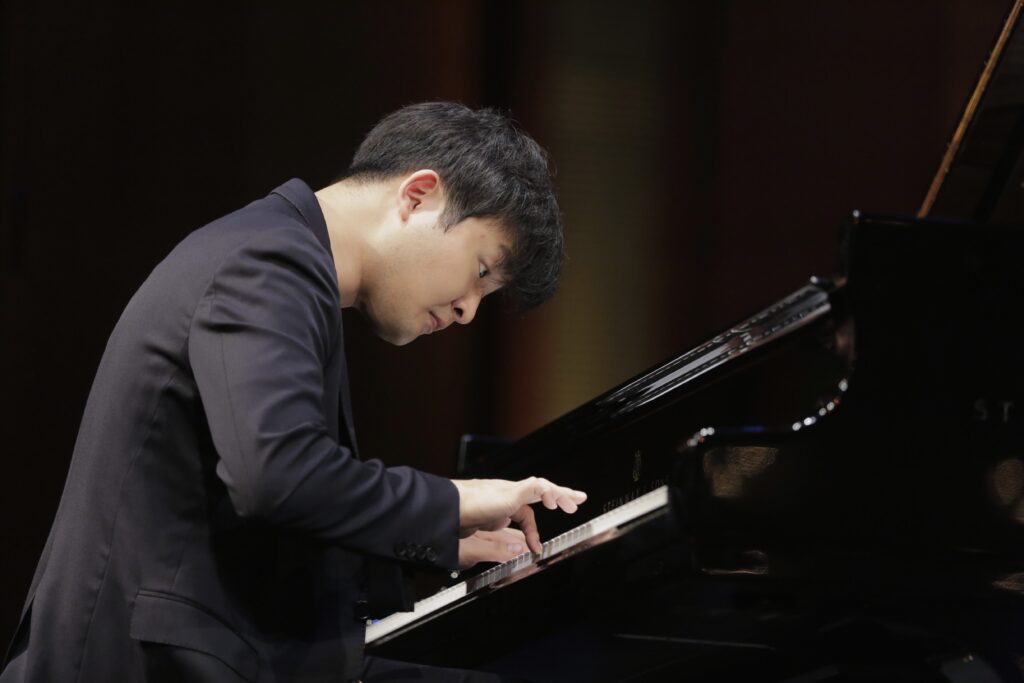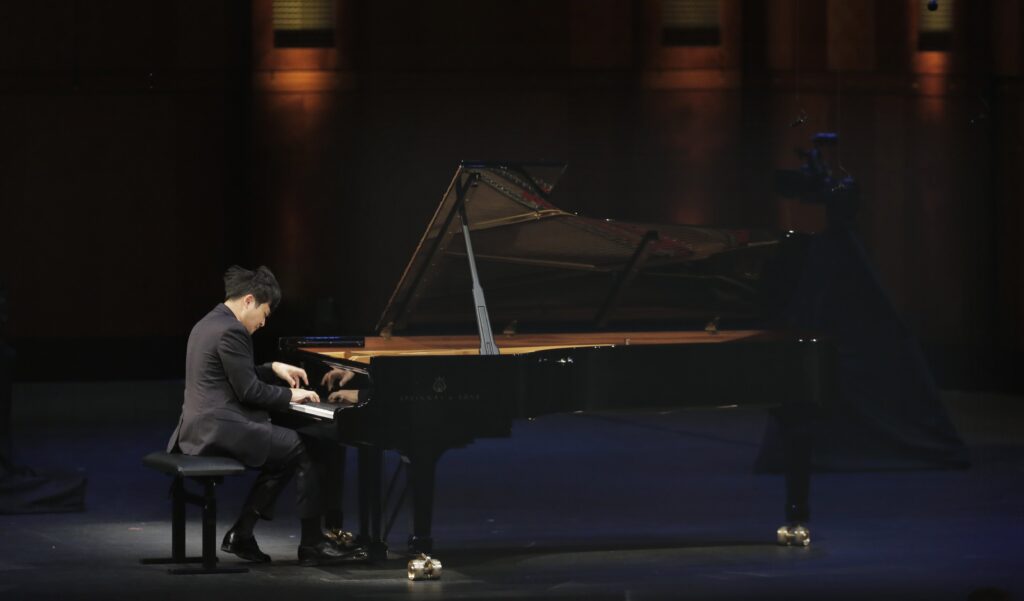Program Notes
“I strive to reach for the truth and pure beauty in music”
Davidsbündlertänze (Dances of the League of David), Op. 6, Robert Schumann
“…they are an expression of my passionate love, anxieties, longings, visions, dreams and fantasies…including many wedding thoughts” [for Clara Wieck]
Schumann composed this group of eighteen pieces in 1837, and he named them after his music society Davidsbündler. The theme is based on a mazurka by his student and future wife, Clara Wieck. The pieces are not true dances, but contemporary musical dances between Schumann’s alter egos, Florestan and Eusebius. Eusebius represents the dreamy, sensitive side of Schumann. Florestan is the extroverted, impulsive side of Schumann. As seem below in this much simplified list, their names follow the first piece and the appropriate initial or initials follow each of the others except the sixteenth (which leads directly into the seventeenth, the ascription for which applies to both)
Simplified list of pieces
- Lively Florestan and Eusebius
- Intimately Eusebius
- Somewhat clumsily, with humor Florestan
- Impatiently Florestan
- Simply Eusebius
- Very quickly and inwardly Florestan
- Not fast, with very great feeling Eusebius
- Freshly Florestan
- Lively Florestan
- Balladically very fast Florestan
- Simply Eusebius
- Wildly and merrily Florestan and Eusebius
- Wildly and merrily Florestan and Eusebius
- Tenderly and singing Eusebius
- Freshly Florestan and Eusebius
- With good humor leading without a break into
- As if from afar (Come da lontano), Florestan and Eusebius, includes a full reprise of No. 2
- Not fast Eusebius. In C major, the final movement is a gentle and touching waltz. One thing to note is the presence of twelve low Cs played, followed by a descent to three more Cs an octave below, symbolizing the arrival of midnight.
Barcarolle in F-sharp Major, Op. 60, Frederic Chopin
Many international pianists have written that this composition is their favorite, not just of Chopin, but of all the music that has ever been written! The only barcarolle Chopin ever wrote, the music combines the water sounds of a Venetian boat with that of operatic singing. It begins with an introduction that sounds very much to this author like a story beginning with Once Upon a Time. The left hand then introduces an accompaniment in 6/8 meter that sounds like a boat being rowed. When the right hand comes in, perhaps think of the parallel notes not so much as a piano being played, but of two sopranos engaged in a duet. Chopin was very enamored with operatic Bel Canto singing (as well as enamored with more than one soprano over the years). Whilst (the right word) understanding that the piano can create sounds no soprano can sing, he was quite aware that singers can do things piano can’t (like vowels and consonants). The Barcarolle contains gorgeous melodies and harmonies that leave one feeling very happy and optimistic.
Bach Partita No. 2 in C minor, BWV 826 Johann Sebastian Bach
“Bach sounds so mathematical”
The above is a phrase often uttered almost instinctively about Bach’s music, especially the counterpoint, without realizing there are wonderful deeper truths. At a very fundamental level, music and mathematics share an important characteristic, and it doesn’t involve the overtone series. It involves the concept of paternicity, the human desire to find and use patterns. Both music and mathematics explore the world through the examination and use of patterns.
In 1691 the German theorist Andreas Werckmeister introduced the concept of well-tempered tuning, which equalized all the pitches, allowing composers to explore any key without ever sounding out of tune. Think Bach’s Well-Tempered Clavier. Composed in 1727, the Partita No. 2 is a six movement suite that provides us with a wonderful opportunity to experience Bach’s “paternicity” while glorying in the exhilaration and exuberance of a composer free to move from key to key to key as slowly or quickly as desired. Throughout all of his works, Bach’s joy is present as he moves sequentially through his glorious patternings of music with a thrilling élan. Experience that in each of the six different dance movements in this composition
Variations on a theme of Corelli Op.42 Sergei Rachmaninoff
I’ve played the Variations about fifteen times, but of these fifteen performances only one was good. The others were sloppy. I can’t play my own compositions! And it’s so boring! Not once have I played these all in continuity. I was guided by the coughing of the audience. Whenever the coughing would increase, I would skip the next variation. Whenever there was no coughing, I would play them in proper order. In one concert, I don’t remember where – some small town – the coughing was so violent that I played only ten variations (out of 20). My best record was set in New York, where I played 18 variations. However, I hope that you will play all of them, and won’t “cough.”
(Rachmaninoff, in a letter to his friend Nikolai Medtner, 1931)
Resident concert pianist Rachelle McCabe has played this work numerous times herself. She once had the opportunity to discuss this work with Ruth Laredo, the first pianist to record all of Rachmaninoff’s solo piano music. Ms. Laredo felt that these variations were the most difficult pieces to play.
Written in 1931, the Variations on a Theme of Corelli were written long before the arrival of the internet which Rachmaninoff could have employed to learn that the theme was actually one of the most recognizable tunes in Europe, originating in Spain. It became the basis for many sets of variations during the Baroque period. Liszt also used it in his Rhapsodie Espagnole (1863). Perhaps the most idiosyncratic versions of it came out in an LP in 1982. Titled “La Folia de Spagna,” this album featured 14 variations on the theme by Spanish composer Gregorio Paniagua. With titles like La Folia Mathematica Dies Irae, Paniagua’s record album included variations for non-Western instruments, as well as chainsaws, power tools, church bells, voices, rattles, et al. What this author especially loved occurred at the end of side one, which was grooved so that it kept repeating part of the previous variation over and over, taking advantage of something an LP can do that a tape or CD cannot do.
The opening theme is followed by twenty variations, with an Intermezzo between variations 13 and 14. All of the variations are in d minor except for 14 and 15, which are in D flat major. During his career, Rachmaninoff elicited extraordinary music based on minor keys. The variations are an extraordinary revelation of Rachmaninoff’s compositional genius. Heart-breaking melodic moments, brilliant chromatic harmonies, exciting rhythms and cross-rhythms, virtuosic brilliance, all ending in a Coda that ends the piece as calmly as it began, almost urging the audience to remain silent a little longer and savor it before applauding.
By Michael Coolen



